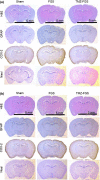Antitumor effect of fibrin glue containing temozolomide against malignant glioma
- PMID: 24673719
- PMCID: PMC4317836
- DOI: 10.1111/cas.12397
Antitumor effect of fibrin glue containing temozolomide against malignant glioma
Abstract
Temozolomide (TMZ), used to treat glioblastoma and malignant glioma, induces autophagy, apoptosis and senescence in cancer cells. We investigated fibrin glue (FG) as a drug delivery system for the local administration of high-concentration TMZ aimed at preventing glioma recurrence. Our high-power liquid chromatography studies indicated that FG containing TMZ (TMZ-FG) manifested a sustained drug release potential. We prepared a subcutaneous tumor model by injecting groups of mice with three malignant glioma cell lines and examined the antitumor effect of TMZ-FG. We estimated the tumor volume and performed immunostaining and immunoblotting using antibodies to Ki-67, cleaved caspase 3, LC3 and p16. When FG sheets containing TMZ (TMZ-FGS) were inserted beneath the tumors, their growth was significantly suppressed. In mice treated with peroral TMZ plus TMZ-FGS the tumors tended to be smaller than in mice whose tumors were treated with TMZ-FGS or peroral TMZ alone. The TMZ-FGS induced autophagy, apoptosis and senescence in subcutaneous glioma tumor cells. To assess the safety of TMZ-FG for normal brain, we placed it directly on the brain of living mice and stained tissue sections obtained in the acute and chronic phase immunohistochemically. In both phases, TMZ-FG failed to severely damage normal brain tissue. TMZ-FG may represent a safe new drug delivery system with sustained drug release potential to treat malignant glioma.
Keywords: Drug delivery system; fibrin glue; glioblastoma; malignant glioma; temozolomide.
© 2014 The Authors. Cancer Science published by Wiley Publishing Asia Pty Ltd on behalf of Japanese Cancer Association.
Figures






References
-
- Stupp R, Mason WP, van den Bent MJ, et al. Radiotherapy plus concomitant and adjuvant temozolomide for glioblastoma. N Engl J Med. 2005;352:987–96. - PubMed
-
- Lawrence YR, Mishra MV, Werner-Wasik M, et al. Improving prognosis of glioblastoma in the 21st century: who has benefited most? Cancer. 2012;118:4228–34. - PubMed
-
- Kaina B, Christmann M, Naumann S, Roos WP. MGMT: key node in the battle against genotoxicity, carcinogenicity and apoptosis induced by alkylating agents. DNA Repair (Amst) 2007;6:1079–99. - PubMed
-
- Caporali S, Falcinelli S, Starace G, et al. DNA damage induced by temozolomide signals to both ATM and ATR: role of the mismatch repair system. Mol Pharmacol. 2004;66:478–91. - PubMed
Publication types
MeSH terms
Substances
LinkOut - more resources
Full Text Sources
Other Literature Sources
Medical
Molecular Biology Databases
Research Materials

